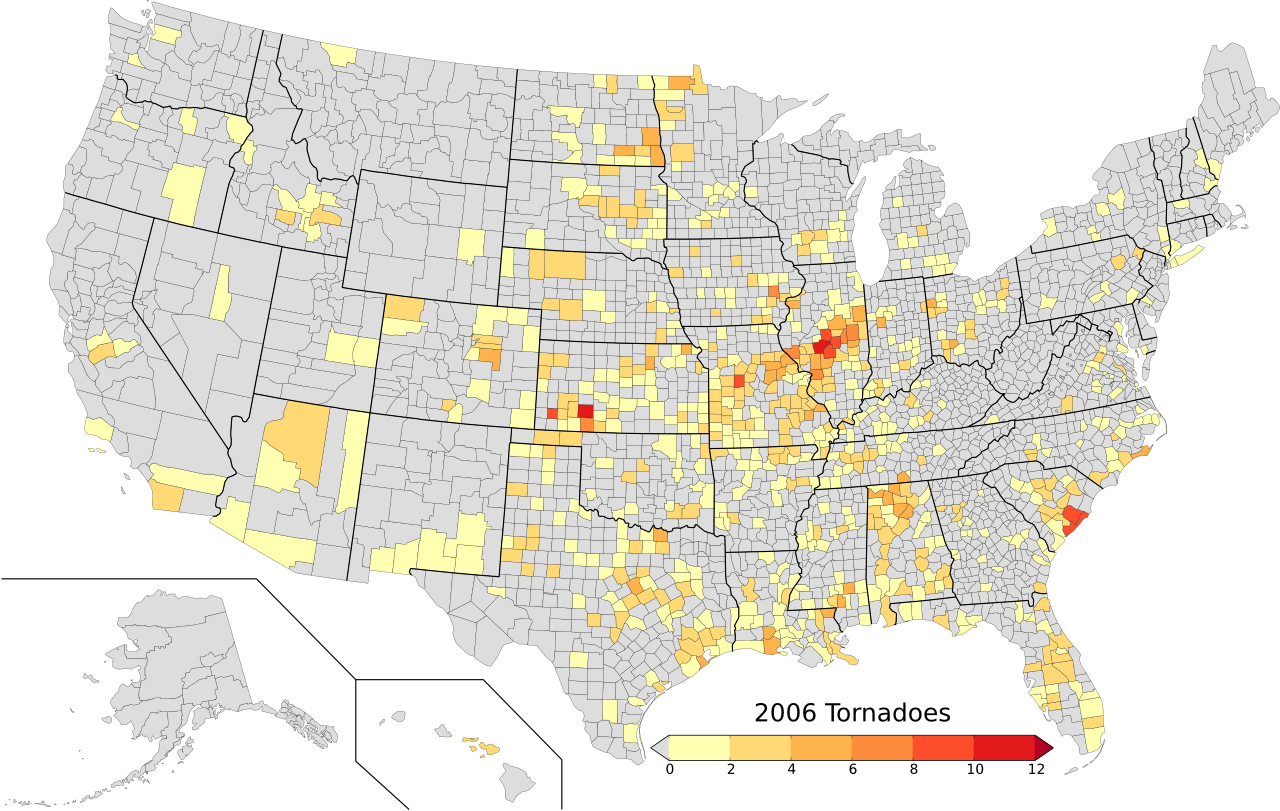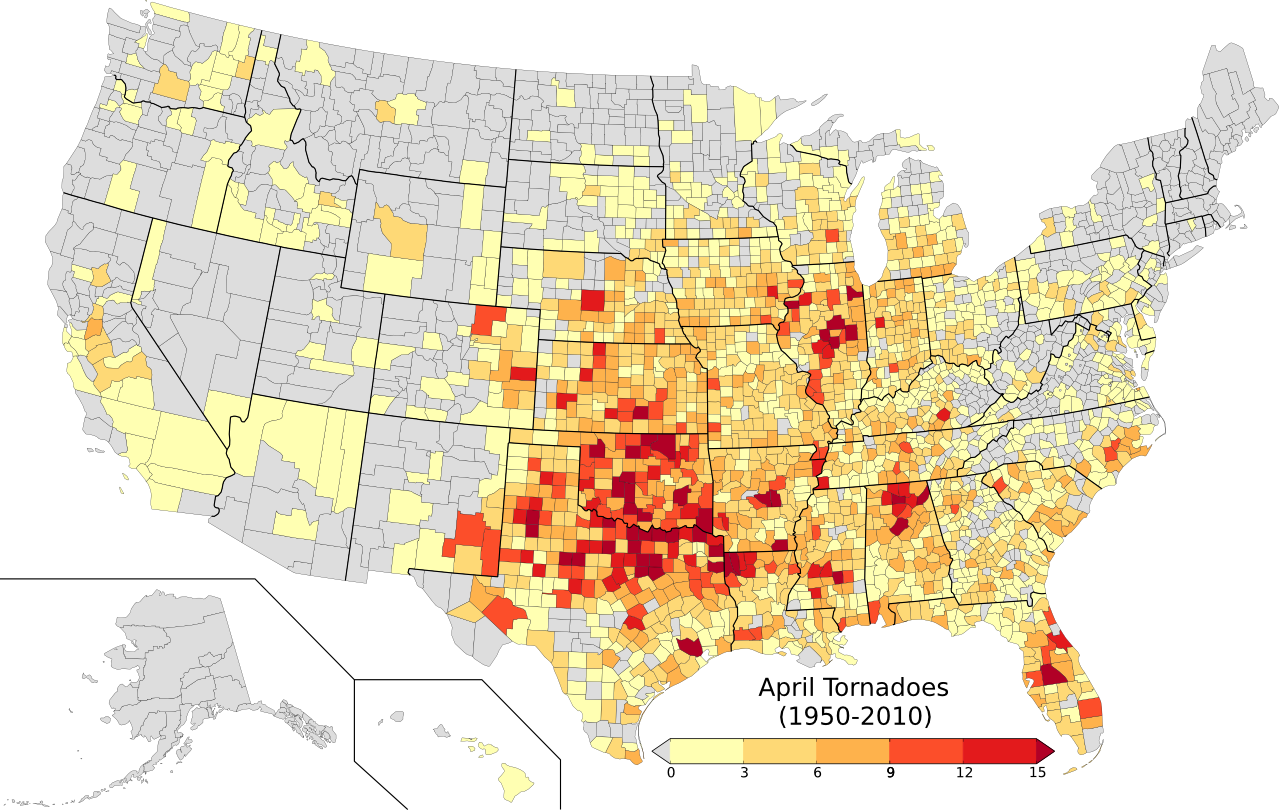UPDATED: 11:30 PM CDT on 25 April 2011
The statistics have been updated to better account for tornadoes that crossed state boundaries. This added 32 tornadoes and 9 fatalities to the Arkansas counts. None of these additional tornadoes were rated violent tornadoes (F/EF-4 or greater). The Arkansas Tornado CSV file has been updated as well.
Several large tornadoes moved through Arkansas this evening, with the worst damage as of this writing coming from the town of Vilonia, AR. Several television stations from Little Rock are now reporting that parts of Highway 64 “are missing”. Anytime reports of pavement being scoured, the talk inevitably turns to discussion about tornado ratings, and comparisons to other pavement scouring tornadoes. Personally, I believe any talk of ratings tonight is premature, however, I went ahead and pulled the Arkansas historical record to help put this event in perspective.
Officially, there has never been a F/EF-5 tornado in Arkansas. Let me repeat that. There has never been an F/EF-5 tornado in Arkansas. In fact, there have only been 26 F/EF-4 tornadoes. If this tornado is rated a violent tornado (EF-4 or EF-5), it will rank among the strongest 2% of all tornadoes to strike Arkansas. If we limit to only tornadoes between 1980 and 2010, only 1.3% of al tornadoes were “violent” tornadoes. Even though most tornadoes are not violent tornadoes, almost half of all tornado fatalities in Arkansas (53) resulted from these 13 EF-4 tornadoes. The fact that there have been so few reported fatalities as of this writing (only 1), is a testament to the National Weather Service in Little Rock and their excellent warnings.
Arkansas Tornadoes and Fatalities (1981 – 2010)
- F/EF0 : 363 (36.37%)........0 fatalities (0.00%)
- F/EF1 : 376 (37.68%)........1 fatalities (0.76%)
- F/EF2 : 172 (17.23%).......24 fatalities (18.18%)
- F/EF3 : 74 (7.41%).........54 fatalities (40.91%)
- F/EF4 : 13 (1.30%).........53 fatalities (40.15%)
- F/EF5 : 0 (0.00%)...........0 fatalities (0.0%)
Total : 998 tornadoes and 132 fatalities
In terms of all Arkansas tornadoes:
All Arkansas Tornadoes (1950 – 2010)
- F/EF Unknown : 16 (1.01%)
- F/EF0 : 436 (27.47%)
- F/EF1 : 568 (35.79%)
- F/EF2 : 387 (24.39%)
- F/EF3 : 154 (9.70%)
- F/EF4 : 26 (1.64%)
- F/EF5 : 0 (0.00%)
Total: 1587 tornadoes
Here are all Arkansas F/EF-4 tornadoes:
All Arkansas F/EF-4 Tornadoes (1950 – 2010)
- 21 March 1952 @ 14:40 (2:40 PM)
- 21 March 1952 @ 16:50 (4:50 PM)
- 21 March 1952 @ 17:00 (5:00 PM)
- 21 March 1952 @ 17:30 (5:30 PM)
- 21 March 1952 @ 18:00 (6:00 PM)
- 19 December 1957 @ 12:44 (12:44 PM)
- 10 April 1965 @ 18:26 (6:26 PM)
- 03 April 1968 @ 18:30 (6:20 PM)
- 19 April 1968 @ 15:12 (3:12 PM)
- 15 May 1968 @ 20:36 (8:36 PM)
- 15 May 1968 @ 20:45 (8:45 PM)
- 26 May 1973 @ 22:30 (10:30 PM)
- 28 March 1975 @ 19:52 (7:52 PM)
- 02 April 1982 @ 17:20 (5:20 PM)
- 24 December 1982 @ 17:00 (5:00 PM)
- 15 March 1984 @ 17:40 (5:40 PM)
- 15 March 1984 @ 19:17 (7:17 PM)
- 14 April 1996 @ 18:10 (6:10 PM)
- 01 March 1997 @ 14:20 (2:20 PM)
- 01 March 1997 @ 14:47 (2:47 PM)
- 01 March 1997 @ 15:25 (3:25 PM)
- 01 March 1997 @ 15:41 (3:41 PM)
- 01 March 1997 @ 18:20 (6:20 PM)
- 16 April 1998 @ 1:50 (1:50 AM)
- 21 January 1999 @ 17:50 (5:50 PM)
- 05 February 2008 @ 16:49 (4:49 PM)

